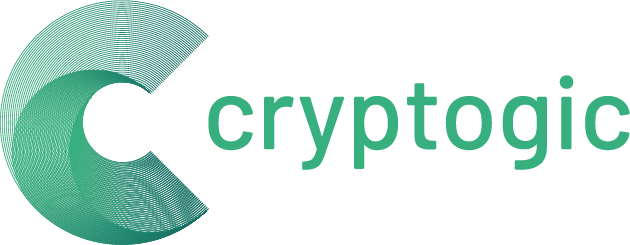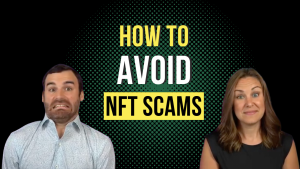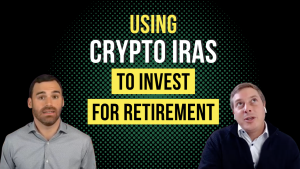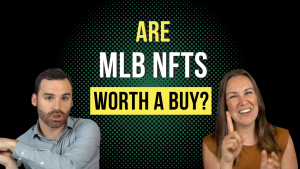Cryptogic provides tools, information, and commentary focused especially on cryptocurrencies, financial and cryptocurrency markets, economic trends, and trading strategies; these tools, information, and commentary are provided for general information purposes only. Neither Cryptogic nor any of its owners or employees are financial planners, investment advisors, or broker-dealers in any jurisdiction. Cryptogic does not provide investment advice, investment services, legal advice, legal services, tax advice, or tax services. Cryptogic does not contain, or constitute, and should not be interpreted as legal advice or opinion. Cryptogic is not a substitute for professional investment advice, tax preparation or legal advice. Consult an investment, tax or legal professional for specific advice about your situation. Click here to read our Website Terms of Use.
NFT ATMs, Marketplaces And More, With Jordan Birnholtz
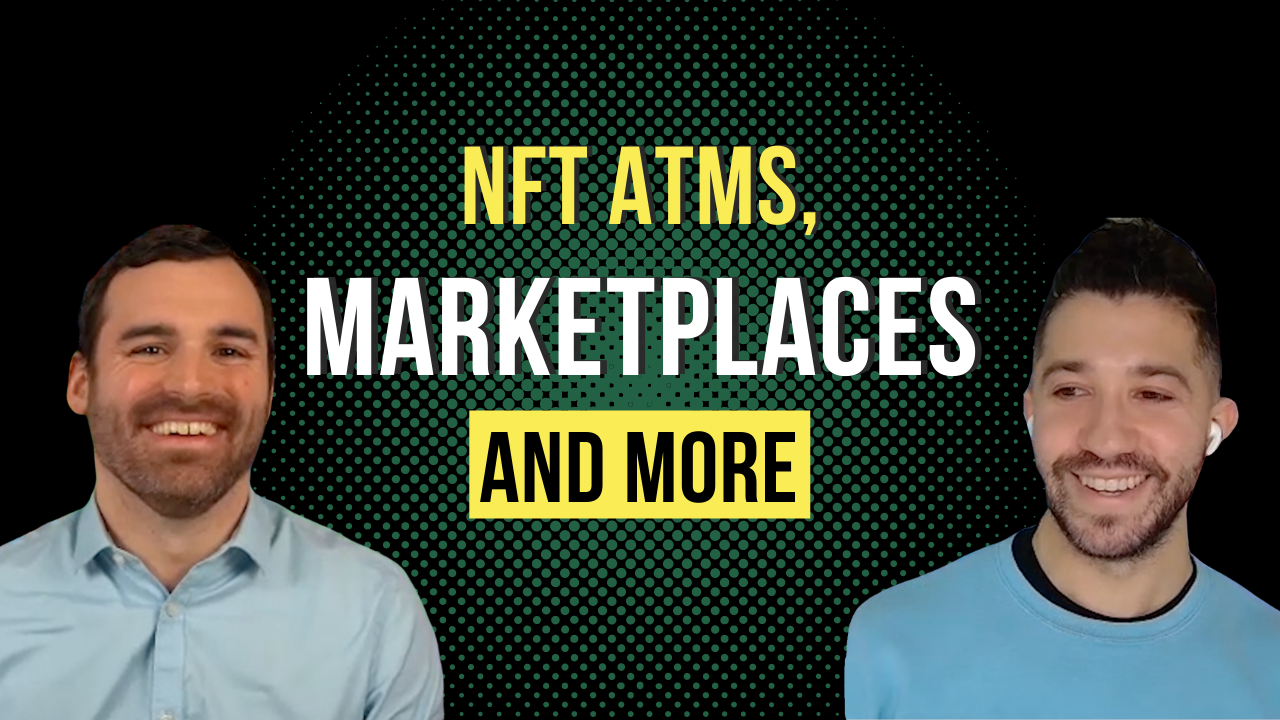
Acquiring NFTs isn’t always as simple as it could be. Fortunately, there are innovative companies working to solve this issue and improve NFT accessibility.
Neon is one such company that offers an NFT Marketplace, and has even launched an NFT ATM which facilitates NFT transactions using cash and not cryptocurrency. Jordan Birnholtz, the CMO and co-founder of Neon, joins to discuss.
Watch On YouTube
Episode Highlights
NFTs For Everyone: “Neon is a marketplace and gallery built on the Solana blockchain. We use Solana for fast transaction times, cheap fees, and a million-fold improvement in energy and environmental efficiency. Neon is supported by a distributed team based in the United States. We accept USD through credit cards and debit cards, and will accept crypto in the future.” (Neon)
From lunch to Solana: Here’s the story of the NFT ATM in New York: “The NFT ATM works very similarly to traditional ATMs. You can purchase NFTs through the machine with your credit or debit card, and it will dispense boxes that contain unique codes that you can redeem through Neon’s platform. Much like Easter egg capsules, buyers will not know what NFT they’re getting until they redeem it.” (Cointelegraph)
Connect With Neon
About The Show
NFT Investor Nation is the show for passionate NFT traders, collectors and investors. Listen in as host Scott talks with leading NFT artists and entrepreneurs.
Connect With NFT Investor Nation
- Listen to NFT Investor Nation on Apple Podcasts
- Listen to NFT Investor Nation on Google Podcasts
- Listen to NFT Investor Nation on Spotify
- Visit our YouTube Channel
Transcript
Scott: Hey, I’m Scott, and welcome to another episode of NFT Investor Nation. Today, we’re going to be talking about NFT marketplaces and NFT ATMs, and a whole lot more. And joining me to offer his insights and share his company’s story is Jordan who is the CMO and co-founder of Neon, which is an NFT marketplace built on the Solana blockchain.
Jordan, welcome to the show.
Jordan: Hey, Scott. Glad to be here.
Scott: Well, thanks for being here. As I said, we were going to talk about NFT marketplaces, NFT ATMs. And Neon has a unique marketplace in the sense that you don’t need a wallet like MetaMask to purchase NFTs on your marketplace. So, my first question is what’s the power of being able to buy an NFT without needing a wallet, with just being able to use old-school cash?
Jordan: Yeah, crypto’s awesome. But our thought is that when I go to Starbucks and I order like a cold brew, I’m not necessarily thinking about what the money supply looks like or the federal reserve, I just give them my credit card and they give me cold brew. The same thing is true when I go to an art gallery, right? Like I give them my credit card.
So, I think that NFTs are a really powerful vehicle for digital artists to make a living, to do what they love, and to build communities. And I don’t think people should have to pay in cryptocurrency to participate in that.
Scott: I mean, I love that because even in the crypto ethos, so to speak, I think there’s a lot of discussion about access and accessibility. And so, if you can only transact in crypto, in a weird way, it kind of goes against that idea of, well, whatever you have, maybe you can access NFTs and pay artists for their work, right?
Jordan: Exactly. And from my perspective, you know, if someone signs up for Neon and they get deeper into crypto, that’s fantastic. And we actually let people connect with their wallet, right? You can connect to Phantom wallet with Neon, if you are a user with that kind of experience. We just want to meet people where they’re at, so that people can get into NFTs, get into crypto for the first time.
Scott: Absolutely. So, I guess with that said, before we go further, can you share a bit more about the story behind Neon, and specifically your NFT marketplace?
Jordan: Yeah, absolutely. So, my really good friend from college, Kyle, was working at Microsoft, I think in their mobile gaming division. And, you know, we’d been friends for years. I’d actually invested in Kyle’s last startup and he lost all my money, and I still wanted to be his friend and work with him. So, that’s how you know he’s a really good dude.
Scott: He’s a good guy, right.
Jordan: Yeah.
Scott: Exactly.
Jordan: So, we went through that process together. He came to me and said, you know, “I want to try building another startup. What are you working on?” And I was initially skeptical because I had been in and out of crypto since 2012. I had gotten really into Bitcoin at the beginning because I had been excited about micropayments for online creators. I had read the Scott McCloud article on micropayments from like, I don’t know, 1999, and I really thought micropayments was the future and that the future was blogging because it was 2012.
And I was dead [beep] wrong, right? If I wanted to be more wrong about the direction of Bitcoin, that would’ve been nearly impossible actually, right? Because it’s not a great platform for micropayments. However, I saw this opportunity to get into NFTs because it’s about supporting creators.
So, he basically said, you know, like, “Look, if your excitement is supporting creators and supporting artists using crypto, this is the right opportunity.”
Scott: Right. Absolutely. And so, then, from there, you guys launched a marketplace. I’m curious if you could share a bit more about the marketplace itself, what does signup look like, how can someone go ahead and say, “All right. I want an NFT and I maybe like to pay cash for it. How can I do it?”
Jordan: Yeah. It’s so easy. So, we wanted to give users the same experience they would get signing up for any other website. All you have to do, either as a buyer or as an artist, is go to neonapp.com and then actually like putting your email address, you’ll go to your inbox, you click on a link to confirm, just like any other site, and just like that, you’ve actually like created a Neon account with a wallet built into it where you store your NFTs and access them from any device.
Scott: So, easy-peasy, basically.
Jordan: Exactly.
Scott: Okay. I’m chopping at the bit to learn more about this. You at Neon, you guys have an NFT ATM which is in New York City. And I know I’ve heard of Bitcoin ATMs. An NFT ATM, what can you tell us about it? How does that work?
Jordan: Yeah. I love the NFT ATM because it’s such a potent metaphor for what our goal is, which is to expand digital art by decoupling cryptocurrency from NFTs. So, we built what is ultimately the easiest way to buy anything, right? It’s a vending machine. So, we’ve built a way to buy NFTs that is as simple as buying a Snickers. And our goal in setting it up in New York City was obviously to reach a really wide audience.
Crypto is very common and very popular in New York City, right? And we’ve been thrilled with the response we’ve got.
Scott: And you set it up where there’s just lots of foot traffic and all that of that – Pretty close to Wall Street, actually. So, yeah, it’s in FiDi. So, you know, we wanted to capture people on their way to work at a bank, truthfully.
Scott: That’s incredible. And so, they can go and they can just browse the art on your marketplace and say, “Okay, I’m just going to buy this?”
Jordan: That’s exactly right. And all they need is a credit card or, you know, you can pay with Apple Pay. And the way it works is that the machine dispenses a box. Inside of that box, there is a card and there’s a redemption code on that card. So, you go to our website, neonapp.com, you click the button that says Redeem, and you put in that string of characters, that’s the redemption code, and it lets you set up a Neon account, obviously for free, and actually redeem that NFT.
Scott: Again, easy-peasy. So, your marketplace is built on the Solana blockchain, and, of course, many folks familiar with NFTs, they’re familiar with the Ethereum blockchain, and all of that. I’m curious, what does Solana do for you in terms of your marketplace, the speed of transactions?
How does it help you?
Jordan: Yeah. We decided Solana was an excellent option because it is clean, right, from an energy perspective, compared to other blockchains, and that’s really important to artists, to be aligned with their values. Also, the transaction times are fantastic and the costs are low. Ultimately, we want people to sell an NFT for 25 bucks, 50 bucks, and be in a world where you don’t have to sell for hundreds of dollars for it to even break even, and Solana was the right choice for that.
So, we’re really excited about all the developments in the Solana ecosystem, but we think it’s particularly useful for expanding the range of people that can create and buying NFTs.
Scott: Well, absolutely. And it’s something I’ve come across in the sense of, you know, the gas fees can be, you know, extreme and depending on the NFT that you’re trying to purchase, it can almost not make sense, right?
Jordan: It’s crazy. Because when I go to an art gallery, they don’t tell me to come back in an hour when the payment processing fees are lower. I think that a lot of blockchain development is really exciting and stimulating and also, a lot of it is people speed-running 19th-century economics lessons.
And I think, you know, that’s part of the natural growth of the ecosystem. And I think that, for us, having something that’s genuinely like low-cost and keeping gas fees low is the key to accessibility alongside accepting fiat.
Scott: I mean, I love that analogy too, of if you’re going to an art gallery, can you imagine just waiting there, “Oh, hang on. Not the right time.”
Jordan: Come back later.
Scott: “Okay. I’m going to go in and buy it now.”
Jordan: Right? Like, I don’t go to 7-Eleven and wait five minutes to buy a Snickers. I don’t know what it is with me with Snickers today. I don’t actually like them, but here we are.
Scott: This show is not sponsored by Snickers.
Jordan: No.
Scott: Though, if you’re hungry, go ahead and grab one.
Jordan: It’s almost noon. It’s fine, you can eat a Snickers.
Scott: I want to speak about art a bit because, of course, art is subjective. But I’m curious, what have you seen about art that performs well on your marketplace, that seems to have more demand and more interest versus maybe pieces that haven’t gotten that much interest? I guess I’m curious to maybe a bit of the taste of your users and what you’re seeing, in general, when it comes to NFTs.
Jordan: Yeah. Absolutely. I think that the art that has performed best on Neon speaks to a core piece of somebody’s cultural identity. I think that Party Pigeons have been successful because of folks’ attachment to music festival culture and the EDM. I think that… We had a collection drop on our platform a couple of months ago by an artist named Finger Trap, who was doing symbols from hip hop and also American sign language, interestingly.
And he found a huge audience with that because people said, “Oh, yeah, you know, that piece of art, that represents music from my neighborhood, music from my city.” And I think that one of the first ways we saw NFT art appearing on the internet was as profile photos. I don’t know that that’s necessarily the entire future, but I think that what people are buying speaks to core pieces of how they see themselves.
I don’t know that that’s, like, fundamentally different from any other, like, kind of art, right? But I do think that is what we’re seeing a lot of early success with.
Scott: Right. I think that… You really hit the nail in the head there, there’s this self-expression. And when you are purchasing art that’s on just a new medium and it’s a whole completely, you know, wide open ocean in the art world, I think that’s all the more important and it attracts people that want to express themselves that way, right?
Jordan: That’s exactly right. And I think that some people have leveled criticisms of NFT art that are not entirely fair. They’ll say, “Oh, I don’t like that piece of art.” Well, have you ever been to the coffee shop down the street and seen the bad art on their walls that they’re selling for $250, right? The truth is that most art doesn’t speak to most people. I’m not going to say most art is bad because that’s like a subjective judgment, and I know better, but most art, like, of doesn’t speak to me and most art doesn’t speak to you.
So, I think that what we do find is that the same rules apply in the NFT world, which is you want to make something that speaks to people’s, like, strongest senses of self.
Scott: Right. You know, as you were saying that, I’m thinking about the last time I took a trip to the MoMA. And, you know, of course, wonderful pieces there, but then sometimes I would see one and I’m like, “Oh, really this?”
Jordan: Yeah, like… And it’s the nature of art.
Scott: Exactly. That’s the nature of it. And I think too, some of that criticism has, you know, come on the backs of you have all this copycat art and something that’s done, you know, there’s nothing unique about it. They’re just trying to ride some… you know, the Bored Ape’s wave or whatever, you know, ape iteration 1 billion, right?
And so, I think that there’s some of that criticism, but then when you get back down to it, it’s all just art, right?
Jordan: And, look, I find derivative art extremely boring. I’m not going to stand here and pretend that I enjoy the billion copy of the Bored Ape Yacht Club. I also recognize that in the real world, there are entire factories full of people who reproduce art commercially. So, this isn’t a new or even that exciting of a phenomenon. It’s a sign that the industry is growing.
Scott: Yeah. I’ve got a van Goh piece on my wall, in my living room, and it’s not an original.
Jordan: Yeah. I’m sorry you can’t…you don’t have an original, but I hope you are wealthy enough to purchase one one day. I want that for you.
Scott: And that’s the goal, right? So, as we’re talking about this, I think there’s always folks that want to look to the future. Where do NFTs go from here? You’ve co-founded a marketplace, so you really are at a unique point where you can kind of see, I guess, the ecosystem. So, what do you see in the future for NFTs, particularly when we’re talking about the art world?
Jordan: Yeah, I see, I think three or four things unfolding. I think that fine art will continue to be a presence in the digital world and that NFTs will be a vehicle for that. We spend a lot of our time online, looking at screens. I think that we will continue to see art that is produced for an increasingly virtual world, much of which will be bespoke, will be fine art, and I do think NFTs will be a for that.
I think the second area where we see opportunity is in collections that don’t just confer access, but have economic value. I think Bored Apes has done a really good job making owning…excuse me… making owning a Bored Ape a useful tool. I’m excited to see what other artists do in that way.
I can imagine a world where an NFT, owning it, entitles you to buy tickets to a music festival three or four days in advance every single year. And that NFT has value because it actually provides a real economic and social benefit. I think that that’s a really exciting possibility.
I know an area where other people are excited and I’m learning more, and I want to be honest about my ignorance, is in gaming. I am really excited to see how NFTs evolve in the gaming world. I think I can be a bit bearish on interoperability between games, but I do think that NFTs could be a really compelling way to improve the digital rights management landscape in a way that’s more user-friendly and more friendly to indie game dev.
So, those are just a few of the areas where I see this evolving, but, you know, our users tell us every day what they want, and I just try to pay attention.
Scott: Yeah. What are the things that some of your users say, “Hey, we really want this?”
Jordan: I think that the thing that shouldn’t have been a surprise but was most exciting was how popular we’ve been on mobile. Eighty-five percent of our purchases have happened on a mobile device. I don’t think that’s true for any other marketplace. And I think that the future of the NFT market looks a lot like the future of the internet, which is one in which most people are engaging with this industry from a mobile device.
So, I think that continuing to focus on a mobile purchasing experience as well as a mobile gallery will be really important.
Scott: Sure, sure. So, we talk about, you know, the exciting future that we can see and the potential options with NFTs. I’m curious, there’s folks, you know, we had this huge run-up in 2021, all sorts of excitement, and it seems like, you know, maybe the whole NFT market has had a little bit of a pullback, and I’m curious, are you long-term?
You’re bullish on NFTs. You think that they’re here to stay and, yeah, “Okay, our prices go up or down.” I’m just curious, to your perspective, if someone’s like, “Oh, is this thing going to be real, or was this all just a big bubble?”
Jordan: Yeah. I think that good art will persist, and I think people will continue exploring new ways to make NFTs useful. And I’m bullish in the long term. I think you’re absolutely right that prices are going to go up and down. I think, very candidly, that reflects people getting quite excited about a new medium and a new way to deliver art and to own art and then coming to have more realistic expectations about what it can do at that moment.
So, I think people talk about a hype cycle. I know that it’s hard to prove that those actually exist, but I think that we are going through that hype cycle right now, and I’m excited to come out on the other side of it.
Scott: Absolutely. And any time you have, you know, a new asset like this, like NFTs, a new collectible, whatever it might be, you’ll have speculative, you know, runs into it, and then some folks might say, “Oop. Oh, maybe I shouldn’t have speculated. I got to get out.”
And you kind of see that fluctuate with prices, right?
Jordan: That’s exactly right.
But then at the core, we’re talking about art. So, the folks that are passionate about the art, are passionate about the self-expression and joining a community, and all of the other potential benefits that haven’t even been realized yet of NFT ownership, I think that’s where that long-term view that I have as well is quite bullish.
Scott: Yeah. Don’t buy things you don’t want is a good philosophy.
Jordan: I think, in general, yeah, that’s like a good life lesson. Like, if you don’t want it, if you don’t truly believe in it, don’t buy it.
Scott: Yeah. I discourage people from… I actively discourage my friends from buying NFTs just because they think they’re going to get alpha on it. I say, “Yeah, maybe, maybe not. You should buy things you like because you like it and because you want to support the artist or because you truly believe that the utility they’re promising is going to come into the world.”
Jordan: Exactly. And that’s why I always recommend, when I get emails or someone reaches out and they want to know, “Okay, well, what should I do?” Look at the project itself, look at the art itself. Do you believe in it? Is the community behind it strong? All of these factors are more important than just focusing on, “Well, what kind of return can I expect here?”
Scott: Yeah. The most boring part of the art world is people fruitlessly speculating on it, right?
Jordan: Mm-hmm.
Scott: That’s true in meet space as well as the metaverse, right? And I think that your advice is good. I think we’re on the same page there.
Jordan: Keeping that focus on the future, what’s next for Neon? Any projects, features, anything coming down the pipeline that you can, of course, share that our viewers might find to be interesting?
Scott: Yeah, absolutely. We have some really exciting drops coming in May and June. We’ve spent the last couple of months trying to improve that mobile experience, which I’m super proud of. And I am excited for those drops. I can’t say what they are yet because we’re still sort of finalizing those details, but I think our fans are going to really like them. We are also… – That’s awesome.
Jordan: …going to be building more NFT art machines, more vending machines in the real world. We’re going to be launching four of them this summer. I would tell you exactly where if I knew exactly where. I have two out of the four cities picked out. So, we’ll see.
Scott: So two different cities though, not just New York.
Jordan: No. We are going to be expanding beyond New York, which I’m thrilled about.
Scott: All right. Well, you don’t have to tell me, but I’m in Chicago. So, maybe send me an email if you finalize something.
Jordan: There’s going to be one in Chicago, so.
Scott: Ooh. I love it. I love it. We’ll have to check it out.
Jordan: Please do.
Scott: All right. Before I let you go, Jordan, thank you so much for joining me, offering such great insights, and sharing Neon’s story. And if folks want to connect, find out more, maybe grab their first NFT from your marketplace, where can they do that? Where should they go?
Jordan: Thank you. Head over to neonapp.com. That’s neonapp.com.
Scott: Awesome. Thanks again.
Jordan: Thank you, Scott.
